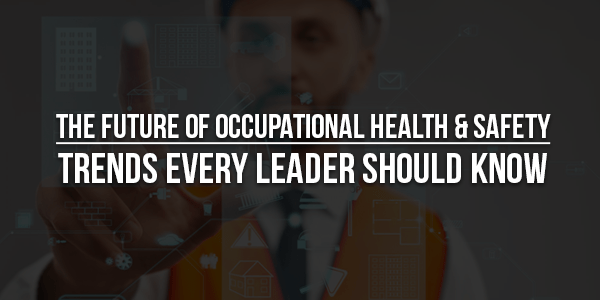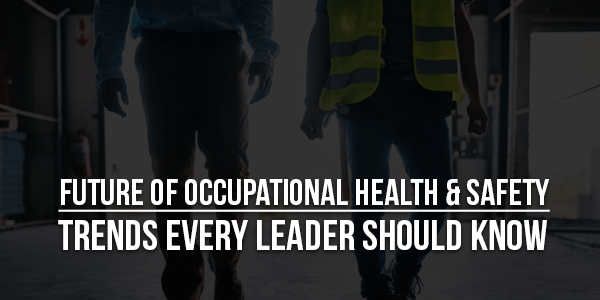
Occupational safety is a debatable topic for employees and businesspeople. As unfavourable incidents and mishaps happen during the occupational period, they can affect a person mentally or physically. Statistics say more than 1.7 million employees have undergone work-related injuries in 2024. The U.S. Bureau of Labour Statistics’ 2023 survey on occupational safety reports that every 1 hour and 39 minutes, a worker loses their life from work accidents. It is slightly better than 2022, where a worker died every 1 hour and 30 minutes.
Whether you are an OHS professional, business leader, HR manager, or student interested in health and safety leadership programs, you must be aware of OHS concepts. In this blog, we will discuss the ongoing and future trends in occupational health and safety and where to pursue an online MBA in health and safety leadership.
Table of Contents
Occupational Health and Safety (OHS)
Despite the type of occupation, Governments and organisations implement proper workplace safety and health programs for the welfare of their employees. Occupational health and safety are followed by organisations to fend off workplace mishaps and promote a protected and healthy working environment for their workers. Professionals who complete the occupational health and safety program have a comprehensive scope of career paths.
- Health and Safety Manager
- Occupational Health and Safety Specialist
- Compliance Officer
- Environmental Health and Safety (EHS) Consultant
- Safety Training and Education Specialist
- Risk Manager
Why Do We Need Occupational Health and Safety Management?
We often notice several people losing their lives while at work. One of the most dangerous jobs that faces a lot of work-related accidents is welding. It is said that 1 in 250 welding workers are getting killed because of accidents and injuries that happen at work. Also, it is saddening to say that every year over 500 construction workers are destined to die due to silicosis (inhaling poisonous dust for a long time that affects the lungs).
Fields such as healthcare, transportation, logistics, and warehousing are also prone to a lot of workplace injuries. Considering these facts, organisations and government bodies propose precautions and safety procedures according to the occupation for the welfare of their employees.
The evolution of working conditions from traditional structure to remote and hybrid requires updated safety and health measures that suit their work structure. Advancements in technologies and work strategies need enhanced safety and health systems that meet their unique requirements.
Importance Of Organisational Safety And Health:
Organisational safety and health focus on the wellness of employees by following standard practices and regulations. Not only does it promote mental and physical well-being, but it also offers the following benefits.
- Increases productivity
- Reduces the non-attendance of workers.
- Protects its employees from anticipated incidents.
- Build trust between employees and employers.
- Minimise costs and financial burdens by reducing accidents.
- Improved quality of work
- Better profit
- Improve brand reputation

Transformation Of Occupational Health And Safety:
From the time when worker safety was largely neglected to the modern era, where employee safety is prioritised with advanced wearables and safety measures, the transformation of occupational health and safety is remarkable. Here are some transformations that have occurred in workplaces over the years that require practical occupational health and safety procedures.
- Growth in robotics and automation brought a positive wave to workplace safety and health practices. In plenty of organisations, automation is used to perform tedious tasks that may be impossible for a normal human.
- Integrating sensors and detectors into wearables like smart helmets and smart watches are contemplating and helpful because it alerts workers when they are exposed to precarious situations.
- Artificial intelligence and machine learning in workplace safety are practical and convenient. It helps with predicting the failure of tools. This prevents malfunction-related accidents.
- The recent post-pandemic has influenced the remote and hybrid work culture. It has improved workers’ job satisfaction and reduced organisational costs.
- Studies say that hybrid and remote working conditions affect the physical health of employees as they spend a lot of time on technology and are sedentary.
- Global warming causes risks to employee health because of high temperatures, allergens, pollution, increased UV radiation, and natural disasters. Streamlined OSH practices should communicate such issues.
Trends – Occupational Safety And Health:
In 2025, the workplace and labour markets will witness enormous changes. Accordingly, the growth of technologies has inclined OSH to a global panorama. According to a survey by Deloitte, 88% of companies believe that modern technological development has an impact on future workforce safety. Now, let’s see the current trends of OSH that lay stress on companies to pay attention to multiple factors.
Automation:
The growth of robotics and automation has not only improved productivity and competence but also created some difficulties to face. It puts OSH in place to pay attention to human and machine interaction, provides guidelines to protect machines from malfunctions, gives practical training for workers, and performs risk analysis.
Mental Wellbeing:
OHS gives priority to workers’ mental wellness, setting up practices to avoid burnout to promote workplace safety. Workers should have an open conversation on mental health, which will make them feel comfortable and secure. Conducting stress management programs, allowing flexible work time, and nurturing work-life balance smoothens employee workplace safety.
Practices To Avoid Cumulative Trauma Disorders:
Companies are coming up with programs and training for employees in appropriate ways and the right posture to handle heavy things, and to avoid musculoskeletal disorders. Planning and preparing jobs that are safe and comfortable for workers, timely detection of musculoskeletal disorders, and performing workplace assessments. The mentioned activities bring down the risks that are linked to workplace calamities.
Safety Equipment:
The post-pandemic has altered the way organizations used to reflect on workers’ health. OSH makes recommendations to companies on having streamlined plans, encouraging the use of Personal Protective Equipment (PPE), a suitable ventilation system, hygiene routines, and remote working procedures. Following such safety measures, employees can protect themselves from infectious diseases and pandemics.
Climatic Changes:
Climate change has affected many companies directly and indirectly. Addressing the issues that occurred due to climatic changes, such as floods, severe heat waves, and earthquakes, can improve employee trust and mental wellness.
Proposed Practices For Occupational Safety And Health:
By now, you should understand that adopting safety and health practices within an organisation can optimise productivity, work satisfaction, and minimise financial losses. Previously, occupational safety and health practices addressed the issues only after they occurred. But modern practices of OSH anticipate the situation and find ways to prevent threatening situations. Some such practices are listed below.
- Training and gaining appropriate knowledge on handling the latest equipment and tools. It helps employees to prevent calamities due to unfamiliarity.
- Find out the prevailing threatening conditions and notify management to amend such situations.
- Investing in personal protective equipment and recommending that workers wear it during work hours will protect them against hazards.
- Never miss periodic breaks during long hours of work. It will help prevent the body from exhaustion.
- Be conscious of your workplace surroundings and emergency procedures, which help during an emergency. Train, learn and get to know the newly proposed safety procedures well.
- Conduct safety audits and assessments with employees regarding the safety environment in the workplace.
- Incorporating mental wellness programs and safety meetings for employees and establishing transparent communication between management and employees regarding safety rules and standards.
- Create a proper mode of contact for reporting inspected threats in the workplace and to put forward personal opinions.
- Avoid dehydration and problems caused by it with the intake of fluids.
Nurturing a safe work environment by putting a safety-first policy and motivating employees to stay proactive brings fruitful outcomes for both employees and organisations. Conducting workshops, seminars, trainings and meetups regarding safety procedures enhances the work atmosphere and empowers workers.
Conclusion:
Businesses, corporates and OSH professionals should follow certain safety procedures to guard workers to provide a safe environment at work. Balancing technological advancements and human safety procedures to build a safety-first environment can bring results that improve the everyday work life of workers.
Suppose you are interested in being an occupational health and safety professional, who is responsible for employee wellness and harmony. In that case, you must check our Online MBA in Health and Safety Leadership program.

 About the Author:
About the Author:
















Be the first to write a comment.